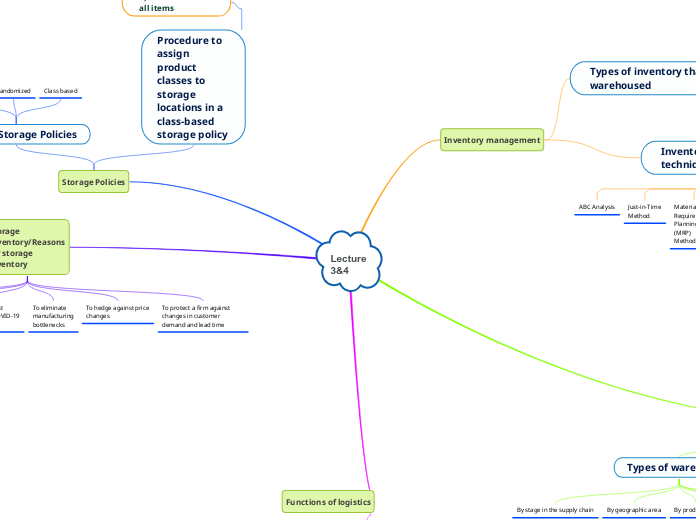Lecture 3&4
Inventory management
Types of inventory that can be warehoused
Cycle stock
Safety stock
Transit inventory or pipeline inventory
Speculative stock
Seasonal stock
Dead stock
Inventory management techniques
ABC Analysis
Just-in-Time
Method
Material
Requirements
Planning
(MRP)
Method
Economic
Order
Quantity
(EOQ) Model
Minimum
Safety Stocks
VED Analysis
Fast, Slow
and Nonmoving
method
Warehouses
Types of warehouses
By stage in the supply chain
By geographic area
By product type
By function
By area
By systems
Flow of material in warehouse
1)Receiving: Goods
2)Inspection and quality control
3)Preparation for transportation
4)Put away
5)Order picking
6)Aggregation of
SKUs
7)Prepration for
transportation
8)Transportation
Order picking
Order-Picking Methods
Storage Policies
Types of Storage Policies
Dedicated
Randomized
Class based
Procedure to assign product classes to storage locations in a class-based storage policy
1)Calculate COI for
all items
2)Sort items in a
nondecreasing
order by their
COIs
3)Allocate the first
item in the list to
the storage
spaces that are
nearest to the
input-output
Storage Inventory/Reasons for storage
inventory
To take advantage of
economies of scale
when purchasing,
transporting and
To balance supply and
demand (to answer
demand as needed)
To hedge against
strikes, fires, COVID-19
etc
To eliminate
manufacturing
bottlenecks
To hedge against price
changes
To protect a firm against changes in customer demand and lead time
Functions of logistics
1. Order
processing
2. Inventory
control
3. Warehousing
4. Transportation
5. Material
handling and
storage
6. Logistical
packaging
7. Information
